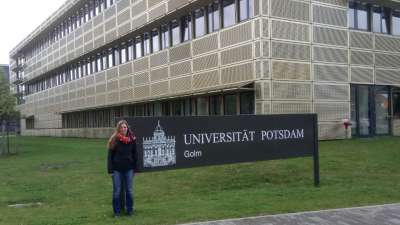- Graduate School GLOMAR
- PhD student reports
- Other activities
- Nora Schulze
Nora Schulze
Report of GLOMAR PhD Nora Schulze about her participation in the "Active Tectonics and the Earthquake Cycle" workshop in Potsdam from 9 to 11 October 2017.
From the 09th to the 11th of October 2017 I attended the workshop 'Active Tectonics and the Earthquake Cycle', which took place at the University of Potsdam at Campus Golm. The group of 10 participants was composed of international PhD students from the University and the GeoForschungsZentrum of Potsdam and one PhD student from Gent. The workshop (http://www.irtg-strategy.de) was led by Dr. Olaf Zielke, senior research scientist at King Abdullah University of Science and Technology in Saudi Arabia.
Goal of this course was to provide a comprehensive overview of the tool kit used to investigate earthquakes and their recurrence. It contained a small theoretical part on eg. stick-slip motion and friction, inter-seismic strain accumulation, and slip rate variation in space and time. The major part of the course, however, were computer- and paper and pen based exercises. All examples came from the San Andreas strike-slip fault system on which Dr. Zielke conducted his PhD research.
Within the three days we interpreted geodetic, stratigraphic, and geomorphic data. Software like AGI Photoscan (http://www.agisoft.com) was used to create either 3D models or digital elevation models (DEMs) from photos by using the method of ‘structure-from-motion’. CloudCompare (http://www.danielgm.net/cc) is a freeware for comparing DEMs with different resolutions and calculating thickness variations eg. induced by a landslide. Furthermore, a MATLAB script written by Dr. Zielke was utilized for 1) identifying and 2) calculating offsets of morphological markers like channels, and 3) recognizing sets of earthquake according to the relation of magnitude and slip rate. Other pen-and-paper exercises included slip rate and gradient of motion calculations and sketches of trench logs to identify the number and chronologic appearance of earthquakes.
The workshop was scientifically very interesting and the atmosphere amongst the participants was very nice, which simplified networking. Moreover, I could widen my software knowledge, especially with MATLAB. As the examples focused on one tectonic setting, the workshop may, in my opinion, be better suited for researchers working with data related to topographic surface expressions of faults.
I would like to thank GLOMAR for providing the financial support to participate in the ‘Active Tectonics and the Earthquake Cycle’ workshop.



